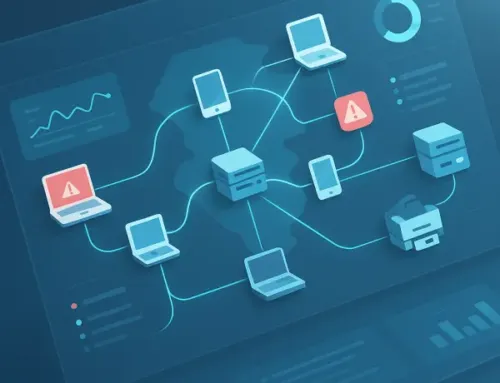How to Identify and Fix Common Network Bottlenecks in Your Business
When your network slows down, so does your entire business. Whether it’s laggy video calls, frozen cloud apps, slow payment terminals, or sluggish file transfers, network bottlenecks can quietly drag down productivity and customer experience, without always making it clear where the problem is coming from.
These performance issues don’t just frustrate your team; they can lead to lost revenue, reduced efficiency, and unnecessary support costs. The good news? Most network slowdowns are fixable – if you know how to identify and address the source.
If your business depends on staying connected (and whose doesn’t?), it’s time to make sure your network is up to the job. Let’s get started.
What Is a Network Bottleneck?
A network bottleneck is a point in your system where the flow of data slows down or gets restricted, preventing information from moving efficiently between devices, applications, or the internet. Think of it like rush-hour traffic: even if the roads before and after are clear, a single jammed intersection can bring everything to a crawl.
Why Bottlenecks Matter
When a bottleneck forms, it can cause:
- Slow internet speeds and buffering
- Dropped VoIP or video calls
- Lag in cloud-based applications and remote tools
- Delays at the point of sale or in customer-facing systems
- Frustration for your team and customers alike
Types of Bottlenecks You Might Encounter
Understanding the source is key to fixing it. Common types of network bottlenecks include:
A network bottleneck can happen anywhere in your system. Identifying where the slowdown is occurring is the first step toward fixing it.
How to Identify Network Bottlenecks
Before you can fix a network bottleneck, you need to recognize the symptoms and locate the source. Bottlenecks don’t always announce themselves clearly. They often show up as general “slowness” or inconsistent connectivity. But with the right tools and a methodical approach, you can uncover where the slowdown is happening and why.
Common Warning Signs of a Network Bottleneck
If your business is experiencing any of the following, a bottleneck may be to blame:
Tools and Techniques to Diagnose the Problem
1. Network Monitoring Software
Use platforms like PRTG, Auvik, or SolarWinds to get real-time visibility into traffic, usage, and device performance. These tools can help pinpoint where congestion or failures occur.
2. Built-In Operating System Tools
Windows: Use Task Manager and Resource Monitor to see which processes are consuming bandwidth.
macOS: Use Activity Monitor or Network Utility for similar insights.
3. Router and Switch Logs
Access your router or switch interface to review traffic loads, device usage, and error logs. Many business-class routers show real-time bandwidth usage per device.
4. Speed and Throughput Testing
Run speed tests from different locations within your network to identify inconsistencies between local and internet speeds. Tools like iPerf can help measure actual throughput across your network.
5. End-to-End Testing
Test both internal connections (e.g., between local devices and servers) and external access (e.g., cloud services or websites) to determine if the bottleneck is inside your network or at the connection point to your ISP.
The best way to solve a network bottleneck is to measure performance and trace slowdowns back to their source, whether that’s a busy router, a bandwidth-hogging device, or a misconfigured setting.
Common Causes of Network Bottlenecks and How to Fix Them
Once you’ve identified that a bottleneck exists, the next step is to zero in on the cause and apply the right solution. Most bottlenecks fall into a few common categories—and the good news is, many are fixable without major infrastructure changes.
Here’s a breakdown of frequent causes and how to resolve them:
1. Insufficient Bandwidth
The Cause: Your internet connection can’t handle the number of devices or the volume of data your team uses – especially with video calls, cloud apps, or large file transfers.
The Fix:
2. Outdated or Overloaded Hardware
The Cause: Old or underpowered routers, switches, or firewalls can’t keep up with modern network demands.
The Fix:
3. Poor Network Configuration
The Cause: Misconfigured IP settings, DHCP conflicts, incorrect VLAN assignments, or a flat network that lacks segmentation can create performance issues.
The Fix:
4. Wireless Interference or Signal Weakness
The Cause: Physical obstacles, too many devices on one access point, or signal interference can degrade Wi-Fi performance.
The Fix:
5. Software and Security Overhead
The Cause: Automated tasks like software updates, backups, or aggressive firewall scanning can eat up bandwidth or slow devices.
The Fix:
Most network bottlenecks come down to insufficient capacity, outdated equipment, or poor configuration, all of which can be addressed with the right combination of upgrades and optimization.
When to Call in a Pro: Managed Network Support
While some network bottlenecks can be solved with simple fixes, others are more complex, and trying to troubleshoot them without the right tools or expertise can lead to more frustration (and downtime). That’s where a managed IT provider can make all the difference.
If your business experiences recurring slowdowns, frequent disconnects, or network-related disruptions that impact productivity, it may be time to bring in expert support.
Signs You Need Managed Network Support
What a Managed IT Provider Can Offer
If network issues are affecting your day-to-day operations (or you don’t have the internal resources to resolve them quickly) it’s worth partnering with a managed IT provider. You’ll gain expert insights, faster problem resolution, and a more stable, secure network.
Network bottlenecks may start small, but they can have big consequences from slowed productivity and frustrated employees to lost sales and poor customer experiences. The key to solving them is knowing where to look, what to watch for, and how to respond quickly and effectively.
By identifying the signs of performance slowdowns, using the right tools to trace the issue, and applying smart fixes you can keep your network running smoothly. And if the problems persist or your business doesn’t have the time or resources to manage it all internally, partnering with a managed IT provider ensures your network is monitored, maintained, and optimized 24/7.
Don’t let a hidden network issue hold your business back. A faster, more reliable network starts with proactive monitoring, smart troubleshooting, and expert support when you need it most.



